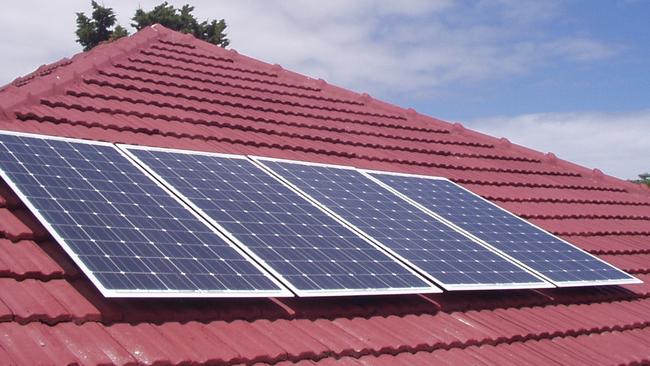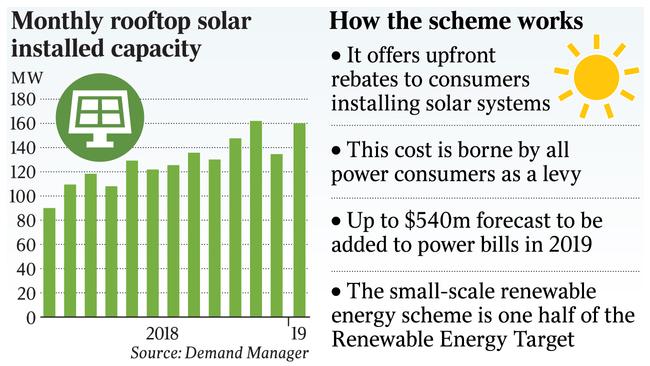Households’ $2bn hit for solar roof panel subsidies
Households will pay nearly $2 billion for rooftop solar installation subsidies this year, costing every home nearly $200.

Households will pay nearly $2 billion for rooftop solar installation subsidies this year, costing every home nearly $200 and threatening to derail Scott Morrison’s pledge to cut power bills.
The cost of the federal Small-scale Renewable Energy Scheme (SRES) and state-based rebates combined is forecast to rise by 45 per cent from $1.2bn last year to $1.74bn this year.
Consumers are flocking to solar power, enticed by cheaper costs and rebates either under way or pledged in Victoria, South Australia and NSW.
Analysis by renewables trader Demand Manager reveals the annual impost for every household for the subsidy is forecast to soar from $134 last year to $195 this year. The cost of the subsidy is added to all electricity bills.
The subsidy hike — on top of already high electricity prices — will intensify pressure on the government to scrap the scheme as it battles to deliver on tariff cuts for consumers ahead of a federal election due in May. The subsidy program is currently scheduled to be phased out by 2030.
Demand Manager owner Jeffery Bye said: “If left unchecked, electricity consumers will be hit with an increase of between $360 million and $540m in the cost of the SRES starting January 1, 2019. Far from subsidies for renewable energy decreasing and Mr (Angus) Taylor being the ‘minister for getting electricity prices down’, it would appear the solar subsidy cost item on electricity bills will be increasing markedly in 2019.”
The Prime Minister was last week forced to shelve the government’s signature “big stick” divestment legislation to deal with market misconduct by energy companies, sparking accusations by Labor that the Coalition no longer has an energy policy. The move followed the Coalition’s abandonment of its national energy guarantee, and left the government’s plan to underwrite new “firm” power generation as its only big-ticket energy policy on the table for implementation before the election.

More than two million Australians have solar installed in their homes. Capacity is growing at 50 per cent a year as consumers seek to capitalise on the rapidly falling cost of the clean energy technology.
However, analysis of the cost of small-scale technology certificates, which are handed to consumers installing solar panels and then bought back by electricity retailers, shows a soaring cost for all power users. Origin Energy revealed last year that the government’s SRES and state-based solar feed-in tariffs accounted for up to 15 per cent of bill charges.
Mr Taylor, the Energy Minister, said the cost of small-scale technology certificates — created to increase the incentive to install rooftop solar — was just 3 per cent of an average household bill. He said the country’s large generator retailers such as Origin, AGL Energy and EnergyAustralia were responsible for a much bigger portion of power prices.
“The big cost is the profits being taken by the big energy companies in the wholesale market, without innovation or new products, and it is time for them to deliver a fairer deal for their customers,” Mr Taylor said.
“According to the Australian Energy Market Commission, the small-scale technology certificate cost is less than 3 per cent of the bill, whereas 46 per cent is going to the big generator retailers.”
The solar boom is partly being driven by state schemes. Victorians are able to install solar panels for about half the usual price under a $1bn-plus Andrews government scheme, while NSW Labor has announced a plan for 500,000 households to install the renewable technology as part of a capped rebate program.
The Australian Competition & Consumer Commission savaged the subsidy last year in its blueprint to reset the national electricity market, arguing that government support for household solar had been well-intended but misguided. Solar schemes were too generous, unfairly disadvantaged lower-income households and had failed to adjust to the changing economics of household solar, it said. Rooftop solar subsidies should be axed and the states should take on the cost of “excessively generous” solar feed-in tariffs to ease the burden of green power schemes the ACCC estimated cost households up to $170 a year.
Consultancy Deloitte says that with solar and wind power competing in price and performance terms with fossil-fuel sources of generation, the clean-energy industry should move on from any ties to subsidies.
The Clean Energy Council said the government should maintain the SRES as it was “one of the few direct ways that households and businesses can take control to reduce their power bills”.



To join the conversation, please log in. Don't have an account? Register
Join the conversation, you are commenting as Logout